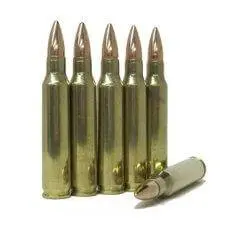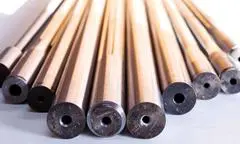
This article by Wayne Anderson is part 3 of a 5-part series about AR-15 barrels. In this article, we will cover the best AR-15 Caliber, Chamber, and the Best Steel Types.
The rest of the series can be found at the links below:
Part 1: Intro, Fundamentals, and Manufacturing of AR Barrels
Part 2: Barrel Length, Gas Systems, and Rifling
Part 4: Profiles, Fluting, and Dimpling
Part 5: Surface Treatments and Muzzle Types
AR 15 Barrels: Caliber and Chamber – The .223 Family
The AR is one of the most versatile rifles ever created. A huge part of that versatility comes from the modular design and the fact that, in just a few seconds, you can remove the upper receiver group, with barrel, bolt carrier, and everything, and swap it out for a different one. It might be a different length of AR 15 barrel, or one with a different grip or sights, but it can just as easily be chambered differently.
A quick look at the Wikipedia entry for AR-15 lists barrels in sixty-six different calibers, ranging from .177 up to .50 Beowulf, and that count doesn’t even include the .410 shotgun barrels, nor the single-shot .50 BMG (and crossbow!) uppers. (Nor does that include any of the larger calibers available for the AR-10-based rifles, originally chambered for .308 Win/7.62 NATO.)
Obviously, covering all those in anything like depth deserves an article of its own, and that’s why we’re not going to get into that here. For this article, we’ll keep it simple, and focus on the .223/5.56mm family.
In fact, we’ll keep it to just three different chamberings, a three-shot group, plus a flyer at the end.
.223 Remington is the civilian round, a very accurate and well-designed round originally designed to fall between the .222 Remington and the .222 Remington Magnum in performance. The bullet is actually standardized at .224″ in diameter, as is the barrel; it’s the lands that are .223. That creates a tight seal for the propellant gases while the lands are cutting their grooves into spinning the bullet, as we discussed above.
It’s notable that the specifications adopted for the .223 Remington chamber by SAAMI (the Sporting Arms and Ammunition Manufacturer’s Institute, aka “Sammy”) call for the chamber to withstand pressures of 55,000 psi. When you shoot the military M855 ammo the pressures can easily reach that high, and can sometimes spike higher. Also, the throat on the civilian .223 Remington chamber is shorter than that of the NATO chamber, as is the leade. This results in slightly better accuracy, but also another increase in chamber pressure.
By contrast, the 5.56×45 mm NATO chamber, which is dimensionally ALMOST identical (and the brass IS identical), has a slightly longer leade, which reduces the actual pressure when the rifling begins to slow the bullet. In addition, the NATO chamber is required to withstand 125% of its rated pressure, resulting in a slightly stronger, slightly heavier chamber construction.
The upshot of all this is that it’s considered perfectly fine to shoot .223 Remington ammo from either a .223R or 5.56 NATO chambered weapon, but shooting 5.56 NATO ammunition from a .223-chambered rifle can result in dangerously high pressures, leading to problems ranging from failure to eject up to and including catastrophic barrel failure. Because of this, the vast majority of AR barrels tend to be chambered for 5.56 NATO, with only a small fraction chambered for .223 Remington.
But that shorter leade, if you recall, gave the Remington chamber a very slight accuracy edge over the NATO chamber. To close this gap, a few “wildcat” chambers (not formally recognized by SAAMI) have been designed, including .223 ArmaLite and, most successfully, .223 Wylde.
The .223 Wylde chamber was designed by Bill Wylde, and is often praised for its combination of .223 accuracy and NATO capability. You can shoot either type of ammo from it, safely, and expect slightly better accuracy than you’d get from a 5.56 NATO chamber. Because of this, a number of manufacturers are chambering barrels in .223 Wylde, and some experts recommend this chamber as the best of both worlds.
And I promised you a flyer at the beginning of this section, didn’t I? Here it is, in case you haven’t guessed: .22 LR (long rifle) rimfire. This “plinking” round, with us since 1887, is the most popular in the world today in terms of sheer numbers sold. It’s inexpensive (ammo shortages aside), relatively quiet, with very light recoil, and it just happens to also be .224″ in diameter.
However, its low power means that it doesn’t provide enough gas pressure to operate a gas-operated rifle like an AR. All AR .22 adapters operate on blowback – that is, simple recoil.
There are two main ways to adapt your AR for .22LR ammo. The simpler and more expensive way is to purchase a dedicated .22LR upper receiver group (URG, including receiver, barrel, handguard, etc.).
At a glance, these typically look exactly like any other AR upper, except that the barrel lacks a gas system. The surprise might be the price – many times a dedicated .22 upper costs around $500 — as much as a good similar upper in 5.56mm! Your first response might be the same as mine: “Why would I buy that when I can get the real thing for the same price?” The answer is simple: Because the next $500 can buy you 1000-1500 rounds of .223 or 5.56mm ammo, or it can buy 5000+ rounds of .22LR. The .22 URG can pay for itself in ammo costs very quickly.
The other way is simpler, less expensive, but it comes with a caveat: You can buy a .22 conversion kit that installs in your existing upper, in place of the regular bolt carrier group (BCG). These use special magazines in the existing magazine well, and they shoot through the regular barrel using blowback rather than the rifle’s gas system. It’s recommended, though, that you shoot only metal-jacketed bullets in these adapted systems, because unjacketed lead (common on .22LR ammo) can foul the rifle’s gas system.
In general, you’ll want to clean your rifle much more when shooting .22LR, because it’s known as a “dirty” round. For the same reason, you may want to choose the chrome-plated adapter.
But, with that in mind, you might want to go ahead and equip yourself to shoot .22LR. It offers low-cost practice, so you can keep up your AR skills with dramatically less impact on your bank account. Many indoor ranges that don’t allow high-powered rifles will welcome you when you’re shooting .22LR. You can also use it to hunt very small game such as squirrels, rabbits, etc.
The Many Varieties of AR-15 Barrel Steel
Steel may just be steel to some people, but to a metallurgist, it’s a whole family of alloys – combinations of iron with traces of other elements, generally including carbon, to increase characteristics like strength, resiliency, hardness, corrosion resistance, and more. To really understand gun barrels, you have to become familiar with the alloys of steel used to make them, and why you might choose one over another.
Steel nomenclature is, in a way, kind of like caliber designations for firearms: There are some simple designations based on numbers that actually tell you something, and then there are other designations that only confuse you. Fortunately, we’re only dealing with a few names and numbers here.
4150 CMV
The 4100 family of medium carbon steels combines favorable strength and reasonable cost, making it widely used in high-pressure tubing and pipes. Of course, rifle barrels are really specialized high-pressure tubes, so it makes sense to find members of the 4100 family in wide use.
4150 is the mil-spec, or military specification, steel, the standard used in the M16s and M4s that the US Military gives to our soldiers, Marines, etc. The 4100 series are medium carbon steels with a careful balance of trace elements. The most important, of course, is carbon, and here the “50” in 4150 tells you something: It averages “50 points” of carbon, or about 0.50 percent of the alloy by weight. The “CMV” you often see at the end is short for “chromium/molybdenum/vanadium”, sometimes called “chrome-moly” steel. Without going into the metallurgy behind it, 4150 makes for a strong, resilient, durable barrel.
4140 CMV
4140 is the little brother of 4150, almost the same, but with 40 points (0.40%) of carbon rather than fifty points. Not quite as strong, not quite as hard, barrels of 4140 tend to cost a little less than 4150 — not because the steel costs less, as it might not, but because it costs less, in time and tooling, to machine the slightly softer steel.
Of course, all other things being equal, that would simply mean the 4140 barrels would wear faster than the 4150s. But this is the real world, and all other things are never equal — as you’ll see when we discuss surface treatments later on.
One more notable thing about the 4100 series steels is that they’re not particularly corrosion resistant. As a general rule, most high-carbon steels are prone to rust, which is why the military specifies a manganese phosphate finish, commonly just called “phosphate” or “Parkerized.”
Stainless 416
Stainless steel isn’t really stainless. Stainless would be more accurately named “stain-resistant,” or “corrosion-resistant,” generally achieved by adding nickel and chromium to the steel’s recipe. The Germans call it “rostfrei,” or “rust-free,” which may be a better way of saying it. These alloying elements, especially the nickel, lend the steel great resistance to oxidation, when compared with a conventional mild or high carbon steel. (Incidentally, that same oxidation resistance renders stainless impervious to Parkerizing, so it’s a good thing it doesn’t need it!)
Oxidation, to steel, usually looks like rust, but it also happens much faster at higher temperatures. A blacksmith will tell you that stainless steels are harder to burn (yes, steel can burn in a forge) but also harder to work – because they’re just plain harder. This means all the operations in making a gun barrel — turning it on a lathe, boring, rifling, drilling the gas port, tapping for muzzle device and barrel extension — everything takes more work. That means it’ll cost more.
But to a lot of people it’s worth it. A stainless barrel can handle exposure to water, even salt water, with very little fear of corrosion. If you put it in your transport case, and there’s condensation on the foam, the barrel won’t rust. A stainless barrel will be harder than an untreated CMV barrel on the inside, too, meaning the rifling will last longer – though some gunsmiths warn that, when a stainless barrel is “shot out”, it doesn’t fail gradually; it goes quickly.
Besides their corrosion resistance, it’s well worth mentioning that stainless steels are considered to be capable of greater accuracy than a CMV barrel. Most of the top competitive shooters use stainless barrels.
It should also be noted that stainless steel barrels shouldn’t be used for full auto firing, as they don’t withstand the heat buildup as well as the more ductile CMV steels.
Crucible 416R
The Crucible Steel Co. has their own version of 416, called “416R,” specifically designed for precision rifle barrels. Crucible claims 416R offers superior strength, machinability, uniformity of microcrystalline structure, and corrosion resistance. While Crucible’s processes are doubtless tightly controlled to produce optimum steel, most of us might never see or need the few percentage points of advantage gained.
“Machine gun steel”
You may see some barrels advertised as being made of “machine gun steel.” This is a 41V45 CMV used by FN (Fabrique Nationale) to produce the barrels for M249 machine guns. The barrel is cold hammer forged (more on that later), then it’s chrome lined to double thickness (more on that later, too!). This is intended specifically for rapid fire weapons, and if you’re using it where full auto (or slide fire, or similar) shooting is permitted, you might want to give these barrels a good look.
On the down side, those barrels trade out accuracy for durability under rapid fire. The chrome lining helps withstand full auto, but it degrades accuracy a little.
One final note on barrel steel: When you hear about barrels wearing out or being “shot out,” this usually refers to the rifling wearing away to the degree that accuracy is no longer acceptable. Naturally, that degree varies – a competition shooter will replace a barrel before it starts shooting 1 MOA (minute of angle, a measure of accuracy), but that 1 MOA barrel could be great for general purpose use.
Either way, the wear begins with the heat and high pressures of the chamber throat and the leade, as the superhot gases (and physical impact of the bullets) slowly erode the rifling from its beginning. Stainless barrels resist this well, but a barrel lined with hard chrome or treated with nitride will still last longer than an unlined, untreated CMV steel barrel.
One Last Tip
If there’s anyone that knows the AR-15 platform, it’s the US military. As a special offer for our readers, you can get the Official US Army Manual for AR-15/M4/M16 right now – for free. Click here to snag a copy.






Which steels can accept a nitride finish?
Outstanding job! Having served in the US Navy and US Army (Nuclear Capable 155 Artillery Forward Observer) in two wars I qualified expert. But I really didn’t get into the detailed specifics and real world results; until I became an Environmental, Safety and Health Director/ risk manager and range safety director at Vilseck Combined Arms Live Fire Range in Germany. Thus, I truly enjoyed your professional explanation to assist me in selection/purchasing an AR-15 w 18” barrel with 15”, full rail. A factor no one ever considers is the size of the soldier. I am 6’-7” 240 odd with a 36” sleeve length arms: would be amusing if you ever saw me handling a STD 16” Barreled AR or
my Mossberg ATI Scorpion Tactical 12 gauge Shotgun! Your articles were exactly what I needed! Thanks,
The 22LR conversion kits sound like a neat idea, but most of the ones I’ve seen online (including here at AT3) are over $200. Maybe I’m cheap, but that seems a bit expensive. I mean, for just a few dollars more, you can buy a whole new 10/22. If they were in the $100-$150 range, they’d be more appealing.
I do like the series on the AR. Keep it up, there’s still plenty of other parts on that rifle to cover.
Like you seem to think I don’t need an AR style 22. I have a Stainless 10-22 and several Ruger 25 round magazines. I put a 4X32 scope on top to help my poor poor eyes and I can hit pretty much whatever I aim at although sometimes I almost miss. LOL. I shot a coyote that was trying to get into my wife’s livestock/zoo and I’m pretty sure I only hit his tail because he was loping along leaving but not that fast and after I shot he took off like a high speed anti aircraft missile. I’ve never seen any dog like animal run that fast except in a Road Runner Cartoon.